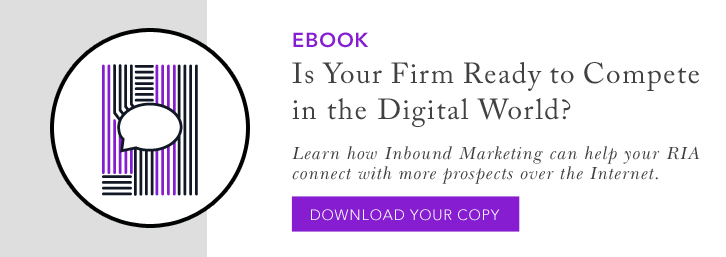

How to Market Yourself as a Virtual Financial Advisor
You are already a virtual financial advisor if your best client moves 1,000 miles away and retains you as his or her advisor. But this is a virtual “servicing” relationship. You had a brick and mortar (face-to-face) relationship before your client relocated to another state.
Virtual “marketing” is more complicated, in particular when you have to compete against brick and mortar advisors and investors’ predisposition for face-to-face contact. It takes some sophisticated marketing tactics to win in the virtual world of financial advice and services.
This article is about building financial advisory businesses that rely on virtual marketing tactics.
The Wall Street Marketing Machine
There is no question, investors are used to the brick and mortar, face-to-face advisor model. It has been that way since Wall Street started marketing financial products to the public. But people also used horse-drawn buggies back then before they converted to a newer method of transportation – the automobile.
A big part of Wall Street’s foundation is a sales culture that is based on employing or licensing hundreds of thousands of advisors and sales representatives in every American city with more than a few thousand residents.
This culture is based on the belief that financial products are sold not bought; therefore, financial service companies need large, decentralized sales forces to sell their products.
It should not be a big surprise that the mega-firms have the best marketing.
You cannot change the industry culture, but you can develop an effective virtual marketing strategy that is competitive with the results that are produced by brick and mortar advisors.
Virtual Servicing
How often do you meet with your clients? Once a year, twice a year, four times a year? It is probably infrequent at best, and when clients have an urgent need to communicate, they pick up the telephone or send you an email. They do not jump in their cars and drive to your office.
Virtual Marketing
Face-to-face is the norm for investors who are used to meeting with advisors for in-depth interviews. You need a marketing strategy that overcomes this investor bias.
At the core of virtual marketing is three questions that should be directed to every prospect:
- Are you seeking the best financial advisor or the closest financial advisor?
- Are you limiting your choice to advisors who are reachable by car?
- Are you willing to consider a virtual advisor?
Why limit your selection to advisors who communicate face-to-face? In modern times, there are better ways to communicate.
Investors should look at all of their choices, brick and mortar and virtual, and select the advisors with the best qualifications, business practices and services.
The more choices they have, the higher the probability they will select the best advisors for the right reasons.
No Geographical Boundaries
Virtual marketing opens the door to statewide, regional or nationwide reach. You are no longer limited to prospects you can reach by car or prospects who are willing to travel by car to meet you for the first time.
The Communication Paradigm
As a virtual advisor, you are not changing the advice and services you provide to investors. You are changing the way you communicate with prospects and clients, in particular when you are in marketing mode.
To be successful, you have to convert the old way of communicating (brick and mortar, face-to-face) to a new way of communicating that is not really that new: Telephone, email, Skype.
The $64,000 Question
Many investors are conditioned not to buy anything over the telephone. You have to overcome this conditioning by proving they are safer when they select you.
You do this by providing a lot of visual information that is accessible using the Internet.
Online proof from third parties that describes your expertise and trustworthiness is particularly effective.
So, here’s the question to ask: If I can prove to you that I am your best choice for a financial advisor, would you be willing to select me as your virtual advisor?
The Ideal Advisor
You need some relevant credentials to make virtual marketing work for you: Experience, education, certifications, etc.
Marketing is also facilitated by a clean compliance record and business practices that benefit investors: Fiduciary, fee-for-service, brand-name custodian, etc.
Independence can also be a factor. It is an important characteristic for financial advisors who do not work for brand-name firms.
The Internet Connection
You should assume more astute investors are going to confirm what you say. This is equally applicable whether you are a brick and mortar or virtual advisor.
In modern times, you should assume investors will use the Internet to check you out. At a minimum, they are going to visit your website and Google search your name and perhaps your firm’s name. They are looking for any information that would cause them to exclude you from their searches.
In an ideal world, they only find information that reinforces your sales claims for credibility and trust.
The Three-Step Selection Process
You should be prepared to participate in a three-step selection process. In fact, you may want to recommend the process to your prospects.
Step One: The initial call to establish mutual interest. You meet the investors’ requirements and they meet your requirements. You have a level playing field with this step because it is conducted over the telephone.
Tip: This is your opportunity to convince investors to conduct the remaining interviews over the telephone or Skype – another way to level the playing field.
Step Two: The in-depth interview is your opportunity to use the Internet to level the playing field again. Take your prospects on a “grand tour” that reinforces your sales claims. Don’t expect them to find the information. You have to show it to them.
Step Three: The final interview means you made the cut. Take advantage of this opportunity to differentiate your services from the prospects’ brick and mortar alternatives. Confront the face-to-face alternative head-on.
The Internet
The Internet is an investor’s best friend when they select a financial advisor. It gives them access to substantial amounts of public data that they can use to verify the information that is provided to them by both types of advisors.
Tip: They usually need to be told where to go on the Internet to find the information.
The Grand Tour
Anything you say on the telephone will come across as a sales pitch – you are convincing the investor to buy what you are selling. For example, you are going to claim you are a credible, trustworthy expert who can help investors achieve their financial goals.
It is much more convincing if you can prove it. This is where the Internet comes into play. You can use Zoom or another service to take the investor on a grand tour that backs-up your sales claims.
If you play your cards right, the Internet will be a powerful part of your virtual marketing strategy. It gives investors access to the public data they need to make their selection decisions.
Your Website
Your tour starts with your website. This is the big picture when you market your firm and personal credentials, business practices and services.
Most of the information may be about the firm, but that is OK. You may be marketing a team of professionals. It is important that your biography reside on the firm’s website under Our Team.
Tip: This is an opportunity to market the team versus an individual.
Your website should be designed to deliver the information investors say they want when they select financial advisors.
You should be able to show investors how you practice full transparency, which is a great way to build trust.
Your Online Visibility
What do investors see when they Google search your name or your firm’s name?
Are they limited to viewing your social connections or do they see articles you have authored that help establish you as an expert in your field? The more articles you have written and published, the more credible you are in the eyes of the investors.
Third-party content that references you or your firm is also a valuable addition, in particular, if the information is back-linked to your firm’s website.
Regulatory Agencies
Very few investors are going to go to FINRA, the SEC or state commissioner websites to check your claims that you are an ethical, trustworthy financial advisor.
You should visit one of these agencies on your tour. It proves you are practicing full transparency and you have nothing to hide. It is safe to assume your competitors do not do this.
Check a Credential
If you have high-quality credentials, you should use the Check a Credential service on the Paladin Registry website to validate quality. Make this a stop on your tour.
This free service provides background information on more than 250 credentials, and there are no registration requirements to view online reports that include quality ratings. This is the most comprehensive database of credentials on the Internet.
Paladin Registry Research Report
If you are a member of the Paladin Registry, you should send prospects a link to your online profile, or better yet, visit the Registry as part of your grand tour and show them your profile.
Include a link to your profile in your “thank you” email. This is one more way you can differentiate yourself from your brick and mortar competitors.
Top 5 Takeaways
If you take anything away from this article, it’s this:
- You must neutralize the impact of face-to-face “sales” tactics.
- The Internet is a powerful sales tool – provide a grand tour.
- Investors retain more of what they see when they select financial advisors.
- The only difference in the long-term relationship is no face-to-face service meetings.
- No more travel by car to attend marketing or service meetings.
You win when the investor wins.

Jack Waymire, BA, MBA
Search Here
Categories
- AI (18)
- blogging (2)
- branding (1)
- content (12)
- custodians (1)
- Digital (345)
- email marketing (3)
- fcmo (2)
- fees (1)
- financial advisor marketing (62)
- Google (3)
- Ideas & Tips (78)
- Investor Experience (7)
- lead generation (7)
- linkedin (1)
- Marketing (371)
- newsletters (1)
- Online Transparency (2)
- search engine optimization (3)
- seo (9)
- Social Media (2)
- video (2)
- Websites (108)
- YouTube channel (2)
Recent Posts
-

-

How Financial Advisor Blogging Generates Thought Leadership and Leads
November 24, 2025 -

Top 5 Ways Digital Marketing Benefits Financial Advisors Seeking Leads
November 20, 2025 -

Trust Is The Biggest Online Marketing Challenge For Financial Advisors
November 17, 2025 -

Compliant Financial Advisor Bios Using AI Website Builders
October 22, 2025

